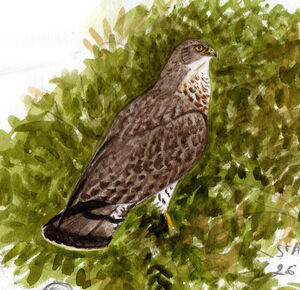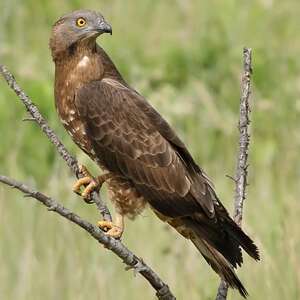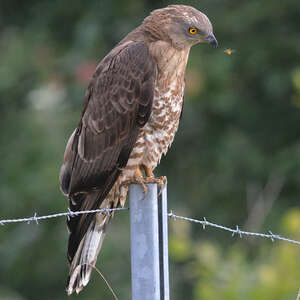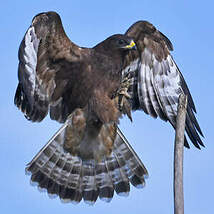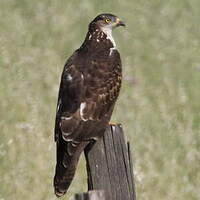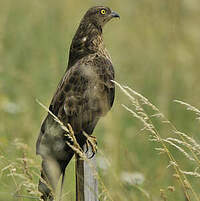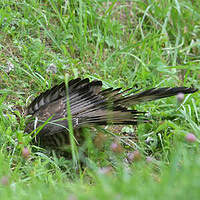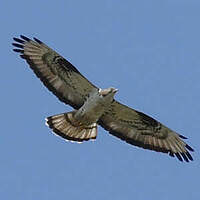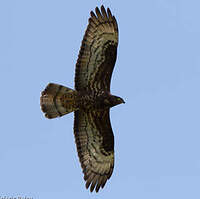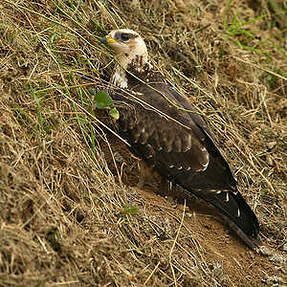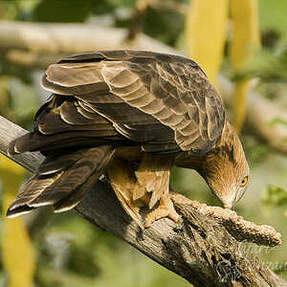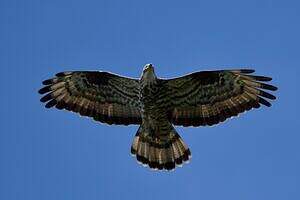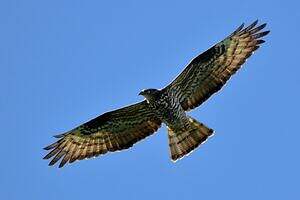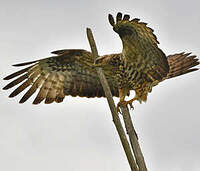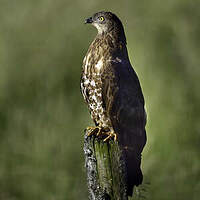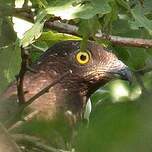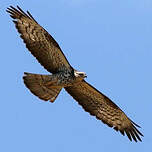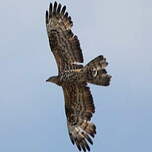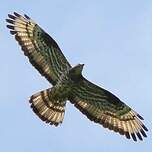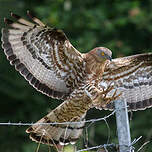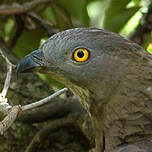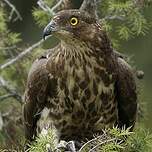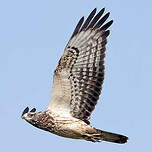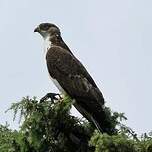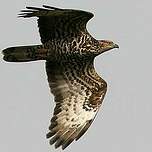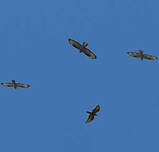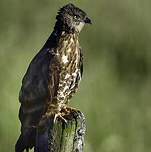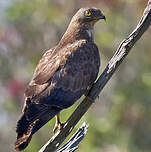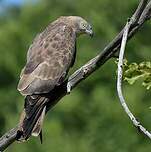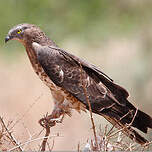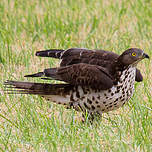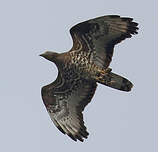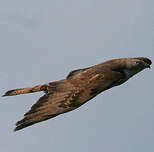European Honey Buzzard
Pernis apivorus - Bondrée apivore
Identification
The European Honey Buzzard is a medium-sized bird of prey, similar in size to the Common Buzzard, our reference raptor, but lighter and sleeker. We distinguish it from the latter by its silhouette and voice rather than its plumage. Indeed, this plumage is as variable as that of the buzzard, but with characteristics specific to the head, wings and tail.
Let's first look at the silhouette in flight.
The head of the European Honey Buzzard is relatively thin and well projected forward of the line of the wings by a fairly long neck. The Buzzard has a wide head that looks almost crammed in.
Other criterion, the flight position of the wings. When gliding, the European Honey Buzzard holds the wings in the plane of its back and slightly downwards at their tips. On the other hand, the Buzzard raises its wings above the plane of its back, somewhat like a buzzard but more subtly.
Finally the tail. The European Honey Buzzard has a rather long tail, at least as long as the width of the wing, or even longer, giving it a particular silhouette. The Buzzard has a tail much shorter than the width of its wing, giving the impression that it is also wider than that of the European Honey Buzzard.
The plumage of the European Honey Buzzard is as variable in colouration as that of the Buzzard, from very pale to very dark in terms of the lower parts, those seen in flight. As a result, we must not focus on the colours but on the designs, especially those of the wings and tail. Both Buzzard and Honey Buzzard have finely barred flight feathers and tail feathers, but these bars are clearly visible on the Buzzard and barely visible on the European Honey Buzzard. Adults have dark tips to the flight feathers and tail feathers forming large wing and tail bars. But what the Honey Buzzard has in addition to what distinguishes it from the Buzzard are the well-defined additional bars at the base of the primaries and especially on the rectrices, usually two, forming a typical well-defined pattern (see photos).Finally, the European Honey Buzzard often has dark wrist patches in strong contrast. Sexual dimorphism is slight but real. The adult male is slightly smaller and lighter-headed.
The juvenile European Honey Buzzard can be distinguished from the adult by the ends of its remiges and rectrices which are much less dark, without a marked bar, but especially by its secondaries that are shaded forming two contrasting dark patches at the base of the wings.
In flapping flight, the European Honey Buzzard has wider, slower, and more supple beats than those of the buzzard.
When you have the chance to have a European Honey Buzzard perched at a reasonable distance, you will notice the thinness of the head, held high, the fine beak with slit nostrils, and finally the robust legs with short tarses, all of which are very typical but require some familiarity and attention. The adult has bright yellow iris and the wax of its beak is grey-blue. The male can be distinguished from the female by his light grey head. The female has a brown head. The juvenile is more delicate to determine as its brown eyes and yellow wax of its beak make it look like a buzzard. It is then necessary to pay attention to the silhouette of the head and the shape of the external nostrils.
Subspecific information monotypic species
Foreign names
- Bondrée apivore,
- Abejero europeo,
- bútio-vespeiro-ocidental,
- Wespenbussard,
- darázsölyv,
- Wespendief,
- Falco pecchiaiolo,
- bivråk,
- Vepsevåk,
- včelár lesný,
- včelojed lesní,
- Hvepsevåge,
- mehiläishaukka,
- Wespedief,
- aligot vesper europeu,
- Býþjór,
- trzmielojad (zwyczajny),
- ķīķis,
- sršenar,
- Осоед,
- ヨーロッパハチクマ,
- 鹃头蜂鹰,
- 西方蜂鷹,
Voice song and cries
The typical call of the European Honey Buzzard species is a modulated whistle of a high pitch, uiiuuuh, usually emitted while flying. It is highly characteristic and allows the species to be identified immediately. It is mainly emitted when the adult birds return to their territory or establish a new one, as a way to express their territoriality. The call becomes much rarer once the nesting has started.
If there is disturbance near the area, the adult emits the same type of cry, but harsher, faster and of a lower pitch.
The juvenile at the nest begs with ui ui ui and tiuk tiuk tiuk.
Habitat
In its western Palearctic breeding area, the European Honey Buzzard needs two types of habitat, mature forest for nesting and open spaces for insect hunting.
Behaviour character trait
During the breeding season, territorial couples only have their nest in mind and do not seek the company of congeners.
However, once the reproduction period is over and the young are independent, there are pre-migratory gatherings and the migration itself is a group migration. The same is true for the spring migration. European Honey Buzzards have more chances of finding the right ascents and routes by mutual observations. Another interesting behavior is the search for food. The European Honey Buzzard has strong, clawed feet, which makes it easy to walk and its claws allow it to dig into soft soil to dig out the nests of Hymenoptera, especially wasps, which it had previously spotted from a lookout point; it will consume the brood and feed its young.Flight
We said above what the gliding flight, with slightly drooping wings, is like. It is clear that this bird, being a big migratory species, is built for long distance journeys, making the most out of its economy of flight.
It knows how to take advantage of updrafts, and it is even more so when they travel in groups.The active flight has slower, much smoother wingbeats than those of a buzzard. The way the wings beat is an additional criterion for the specific identification of the European Honey Buzzard.
Dietfeeding habits
The European Honey Buzzard is mostly insectivorous. As suggested by its specific name apivore, meaning eater of bees, it mostly looks for colonial Hymenoptera such as wasps or bumblebees, and especially their brood, meaning the fleshy larvae developing in a nest, which are very nutritious.
It is easy when it comes to aerial nests, which are easily accessible. It is different when it comes to nests hidden in the ground which she needs to extract by scratching. Her strong and clawed legs allow her to do this. Skin around the base of the beak and near the eyes is protected from stings by short and wiry feathers resembling scales.
The brood is eaten there or carried to the roosting area to feed the chicks. This diet has an impact on the phenology of migration. The Honey Buzzard is a late migrant, that only arrives in May, once the populations of prey insect are abundant.
Thankfully, for her, the domestic bee and its brood are protected from the Honey Buzzard's predation by the apiculturist's hive.
This diet is specific to the breeding season and requires an adequate amount of time. If the Hymenoptera lack or are less accessible, the Honey Buzzard turns to other invertebrate and even vertebrate preys, various arthropods (insects and others), amphibians, lizards and even small birds when the opportunity presents itself, taken from the nest for example. She is capable of capturing large insects in flight, for example during emergences (dragonflies, butterflies, pearls, ...).
Reproduction nesting
European Honey Buzzards arrive late in the spring due to their insectivorous and especially apivorous diet. The honeybee brood they feed on is only available in abundance in the summer.
Couples often arrive at the breeding site already paired. They can then make use of the previous year's nest if it is still in good condition, or build a new one. At the same time, the pair demonstrates their territoriality and sexuality through aerial displays. The male performs his nuptial flight that includes a species-specific phase. He rises gradually due to the air currents, punctuating his orbits with his plaintive cries, and then at a given moment stops in the sky, raising his wings and shaking them three or four times over his back.
The nest is located high up in a tree, of variable size depending on the support. It is larger if an old raptor's nest serves as a base. Inside it is lined with leafy branches, a specific characteristic that will be renewed regularly during the nesting period. The female usually lays 2 eggs (1 to 4) of variable colouration, 3-5 days apart. Incubation begins once the laying is complete and lasts about 33 to 35 days, mainly carried out by the female. The chicks are fed by both parents. The male brings the honeycomb from the nests of hymenoptera that he has collected and the female extracts larvae and nymphs which she distributes to the young. When the male brings a frog, he first peels it far from the nest before giving it to the female. The young will be able to fly at the age of one and a half months but will still depend on the adults for two to three months for provisions. At the age of one month, they are able to feed themselves with what the male brings.
Geographic range
The European Honey Buzzard's breeding range extends from the Atlantic to the approach of Mongolia in the Western Palearctic area. It is well-present in Central Europe but less common in the British Isles. In Scandinavia barely reaching the Gulf of Bothnia. It is present in West Russia but avoids Kazakhstan.
Southward, it occupies most of the Iberian Peninsula, the Italian boot, the Balkan Peninsula, Turkey, the Caucasus and Northern Iran.
The wintering grounds are throughout sub-Saharan Africa. The migration route is funneled by straits that minimize movements over the sea where the air is less supportive, the Strait of Gibraltar, Cap Bon, the Bab el Mandeb Strait, the Strait of Hormuz,... The passage at Gibraltar can be spectacular.
Threats - protection
IUCN conservation status
concern
in the Wild
threatened
evaluated
The European Honey Buzzard can only suffer from the current climate changes that affect the invertebrate biomass on which it depends, but the extent to which this affects it is still unknown. There are also all the risks it can encounter during its long-distance migratory movements. Finally, there are direct destructions. For a long time, in our country, the Honey Buzzard was shot as a pest on its migration routes, which were well identified, due to a total lack of knowledge of its biology. It was also a kind of sport practiced by French gun carriers, mainly in the south. Fortunately, this practice must have disappeared due to the official protection of all raptors and probably due to a change of consciousness of the hunting world. It is not surprising that these practices have long caused a decline in the species. Fortunately, the Honey Buzzard has its natural discretion in its reproduction areas.
Sources of information
- IOC World Bird List (v14.1), Gill, F and D Donsker (Eds). 2024-04-18.
Other sources of interest
 Specification sheet created on
27/07/2023 by Jean François
Specification sheet created on
27/07/2023 by Jean FrançoisTranslation by AI Oiseaux.net
published: 15-02-2023 - Updated: 15-02-2023
© 1996-2024 Oiseaux.net
- Accipitriformes
- Aegotheliformes
- Anseriformes
- Apodiformes
- Apterygiformes
- Bucerotiformes
- Caprimulgiformes
- Cariamiformes
- Casuariiformes
- Charadriiformes
- Ciconiiformes
- Coliiformes
- Columbiformes
- Coraciiformes
- Cuculiformes
- Eurypygiformes
- Falconiformes
- Galliformes
- Gaviiformes
- Gruiformes
- Leptosomiformes
- Mesitornithiformes
- Musophagiformes
- Nyctibiiformes
- Opisthocomiformes
- Otidiformes
- Passeriformes
- Pelecaniformes
- Phaethontiformes
- Phoenicopteriformes
- Piciformes
- Podargiformes
- Podicipediformes
- Procellariiformes
- Psittaciformes
- Pterocliformes
- Rheiformes
- Sphenisciformes
- Steatornithiformes
- Strigiformes
- Struthioniformes
- Suliformes
- Tinamiformes
- Trogoniformes

